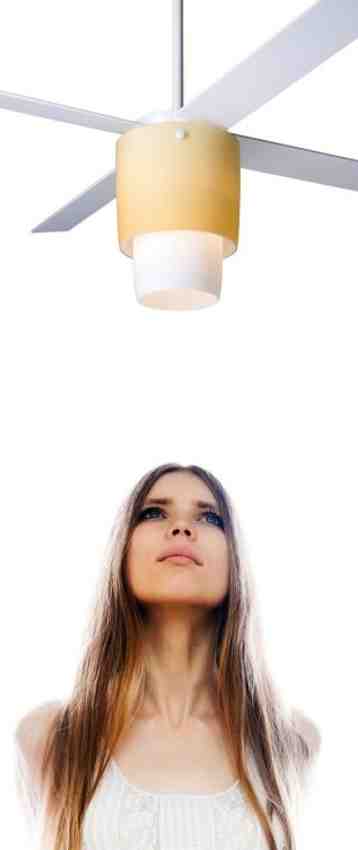
At a time of power outages due to peak consumption of air-conditioning, that is a socially useful benefit. It is technically possible to run a 110 AC off solar panels in very bright sunlight, but only at the expense of just about every other appliance in the home. And only with a fairly massive battery pack. And only for a relatively short time. Celing fans on the other hand can keep going all day on a fairly low power supply. Some were designed especially for running directly off solar panels with no battery – for use in drying cannabis in California’s Emerald triangle.
And ceiling fans have other benefits.
There is nothing artificial about the air they circulate, compared to the staleness of conditioned air. In Cities, ceiling fans provide a kind of white noise that is especially useful at night for keeping traffic noise at bay when you want the cooling breeze of an open window. And aesthetically they provide a nice sense of movement. Set ceiling fans in a counterclockwise position to pull cool air up.
The American Lighting Association offers these tips about how to use ceiling fans and size them specifically for your rooms.
Multiple uses
Ceiling fans serve three primary purposes; the first is air movement.
“In summer, ceiling fans create a ‘wind chill’ effect that makes the room feel 6 to 8 degrees cooler than the actual ambient temperature,” said Joseph Rey-Barreau, associate professor in the College of Design at the University of Kentucky. “In winter, the direction of the blade movement can be set to a counter-clockwise direction, which will help to move the hotter air at the ceiling toward the edges of the room and then downward. This distributes the heated air more efficiently.”
That is key to consumers’ interest in and need for ceiling fans.
“That air movement can help reduce heating and air conditioning bills in homes,” said Maria Scutaro, president of Murray Feiss Lighting/Monte Carlo Fan Co.
Manufacturers have also adapted ceiling fans to fit the smallest of spaces — even in closets — with a single blade and minimal motor that leaves the ceiling fan able to hug the ceiling.
While the Energy Star label gives homeowners guidance about which appliances can save on utilities, ceiling fans can also be rated Energy Star compliant. To do that, those ceiling fans must use efficient motors and advanced blade design to meet or exceed minimum requirements for airflow efficiency set by the U.S. Environmental Protection Agency.
Energy Star ceiling fans also carry three warranties: a minimum 30-year on the motor, a one-year on other components and two-year on lighting.
“Lighting for Energy Star-qualified fans also uses efficient compact fluorescent sources that use two-thirds less energy and produce 70 percent less heat than incandescent bulbs,” Rey-Barreau said.
Three location ratings
Ceiling fans used indoors in protected spaces differ from those used in semi-protected or exterior spaces. An indoor use rating means a fan can be used only indoors. Those rated damp use can be used outdoors if in a covered spot, such as a porch. An outdoor use rating means the fan can be used in a location where it will be exposed directly to water, such as over a patio that is located underneath a deck.
One common mistake
“The better quality fans do not cost much more than the most inexpensive fans,” Rey-Barreau said. “A consumer should purchase a fan that has a good motor and is energy efficient. Buying a very inexpensive fan can be problematic in terms of performance.”
Sizing basics
In order for a ceiling fan to effectively heat and cool a space, it must be sized for the square footage of the room. Use these room measurements as guidelines:
Less than 50 square feet — 29-inch fan
75 square feet — 36-inch fan
100 square feet — 42-inch fan
225 square feet — 52-inch fan
300 square feet — 56-inch fan
More than 300 square feet — a 60-inch fan or two 56-inch or 52- inch fans
How many blades?
Traditional ceiling fans have an average of 5 blades, though some might have only four or as much as six.
• The three bladed fans lend an art deco appearance.
• Fans with blades, resembling large leaves, add a tropical flair to the abode.
• Wicker blades bring the days of plantation living home.
• Blades crafted from sail cloth fabric are perfect for the beach themed room.
• Themed fans look like toys on the ceiling in the children’s rooms or playrooms.
• Twin fans can really work a room.
• Fans in multiple colors will had fun to the kid’s playroom.
• Beautiful fans are designed with the blades opening up to appear like a flower.
• Beautiful traditional looking fans add the elegance of a chandelier with shades and crystals.
• Two bladed fans will lend a breeze with a contemporary flair.
• Fans come that are made from sustainable resources such as bamboo.
• Industrial fans of the past are now chic as ceiling fans giving the décor a sleek industrial look.Modern industrial fans such as 6ixBlade industrial ceiling fans can dramatically reduce operating costs for businesses.
A cool breeze will lull you off to dreamland. Feel the wind, turn up the music and forget the day’s worries.
One Response
There are also low-voltage ceiling fans available for those who have 12 v. [or other] offgrid homes. Or have low voltage available. The ceiling fans in our cottage are 12-volt fans and use a tiny amount of electricity, a few watts at lowest setting, a little more at higher settings. They are not cheap: ours cost around $160 apiece, and 110-volt fans can be had for half that. However, once bought and installed, one’s electricity usage for the fans is close to negligible.